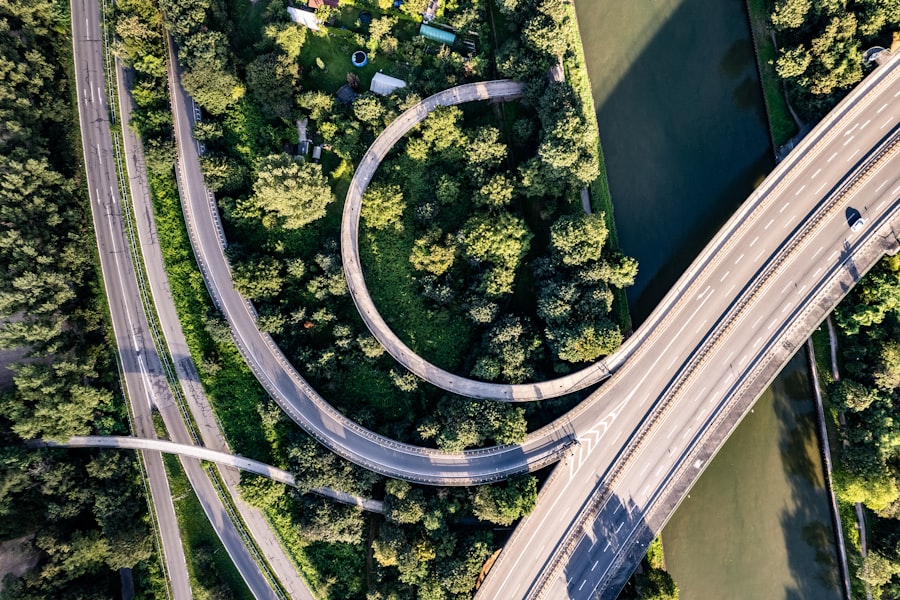The advent of smart transportation systems marks a significant shift in how urban mobility is approached, particularly in the context of carbon reduction. As cities grapple with the challenges of congestion, pollution, and climate change, the integration of technology into transportation networks has emerged as a viable solution. Smart transportation encompasses a range of innovations, from connected vehicles to intelligent traffic management systems, all aimed at enhancing efficiency and sustainability.
The overarching goal is to create a transportation ecosystem that minimizes carbon emissions while maximizing accessibility and convenience for users. Carbon reduction is a pressing global concern, with transportation accounting for a substantial portion of greenhouse gas emissions. According to the Environmental Protection Agency (EPA), transportation contributes nearly 29% of total greenhouse gas emissions in the United States alone.
This statistic underscores the urgency of adopting smart transportation solutions that leverage technology to reduce reliance on fossil fuels and promote cleaner alternatives. By harnessing artificial intelligence (AI) and other advanced technologies, cities can develop smarter, more efficient transportation systems that not only alleviate traffic congestion but also significantly lower carbon footprints.
Key Takeaways
- Smart transportation plays a crucial role in reducing carbon emissions and creating a more sustainable environment.
- AI technology is revolutionizing smart transportation by enabling efficient traffic management and predictive maintenance for vehicles.
- AI-enabled traffic management systems help in reducing congestion and improving overall traffic flow.
- AI-powered predictive maintenance for vehicles helps in identifying and addressing potential issues before they become major problems, leading to safer and more reliable transportation.
- AI-driven route optimization for public transportation improves efficiency and reduces fuel consumption, contributing to carbon reduction efforts.
The Role of AI in Smart Transportation
Artificial intelligence plays a pivotal role in the evolution of smart transportation systems. By processing vast amounts of data in real-time, AI can enhance decision-making processes across various facets of transportation. From optimizing traffic flow to predicting maintenance needs for vehicles, AI’s capabilities are transforming how cities manage their transportation networks.
The integration of AI allows for more responsive and adaptive systems that can adjust to changing conditions, ultimately leading to improved efficiency and reduced emissions. One of the most significant advantages of AI in smart transportation is its ability to analyze data from multiple sources, including traffic cameras, sensors, and GPS devices. This data-driven approach enables cities to identify patterns and trends that inform infrastructure planning and operational strategies.
For instance, AI algorithms can predict peak traffic times and suggest adjustments to traffic signal timings, thereby reducing idling times and lowering emissions. Furthermore, AI can facilitate the development of autonomous vehicles, which promise to revolutionize urban mobility by reducing accidents and optimizing fuel consumption.
AI-Enabled Traffic Management Systems

AI-enabled traffic management systems represent a cornerstone of smart transportation initiatives. These systems utilize machine learning algorithms to analyze real-time traffic data, allowing for dynamic adjustments to traffic signals and routing strategies. By optimizing traffic flow, these systems can significantly reduce congestion and associated carbon emissions.
For example, cities like Los Angeles have implemented AI-driven traffic management solutions that adapt signal timings based on real-time traffic conditions, resulting in smoother traffic flow and reduced travel times. Moreover, AI traffic management systems can integrate with other smart city technologies, such as connected vehicles and public transportation networks. This interconnectedness allows for a holistic approach to urban mobility, where data from various sources informs decision-making processes.
For instance, if an AI system detects an accident on a major thoroughfare, it can automatically reroute public transit vehicles and provide real-time updates to commuters via mobile applications. This level of responsiveness not only enhances the user experience but also contributes to lower emissions by minimizing unnecessary idling and detours.
AI-Powered Predictive Maintenance for Vehicles
Predictive maintenance is another area where AI is making significant strides in the realm of smart transportation. By leveraging machine learning algorithms and data analytics, predictive maintenance systems can forecast when a vehicle is likely to require maintenance or repairs. This proactive approach not only enhances vehicle reliability but also contributes to carbon reduction by ensuring that vehicles operate at optimal efficiency.
For example, fleet operators can utilize AI-powered predictive maintenance tools to monitor vehicle performance metrics such as engine temperature, fuel consumption, and brake wear. By analyzing historical data and identifying patterns, these systems can alert operators to potential issues before they escalate into costly breakdowns. This not only reduces downtime but also ensures that vehicles are running efficiently, thereby minimizing fuel consumption and emissions.
Companies like UPS have already adopted such technologies in their logistics operations, resulting in significant cost savings and reduced environmental impact.
AI-Driven Route Optimization for Public Transportation
Route optimization is a critical component of effective public transportation systems, and AI is revolutionizing how transit agencies approach this challenge. By analyzing real-time data on passenger demand, traffic conditions, and historical ridership patterns, AI algorithms can identify the most efficient routes for buses and trains. This optimization not only improves service reliability but also enhances the overall user experience by reducing wait times and travel durations.
Cities like Singapore have implemented AI-driven route optimization solutions that dynamically adjust bus routes based on real-time demand. For instance, during peak hours or special events, the system can reroute buses to areas with higher passenger volumes, ensuring that resources are allocated efficiently. This adaptability not only increases ridership but also contributes to carbon reduction by encouraging more people to use public transit instead of personal vehicles.
As more cities adopt similar technologies, the potential for reducing emissions through optimized public transportation becomes increasingly significant.
AI-Integrated Electric Vehicle Charging Infrastructure

The transition to electric vehicles (EVs) is a crucial element in the quest for carbon reduction within urban transportation systems. However, the effectiveness of this transition hinges on the availability and accessibility of charging infrastructure. AI plays a vital role in optimizing EV charging networks by analyzing usage patterns and predicting demand for charging stations.
For instance, cities can deploy AI algorithms to assess where charging stations are most needed based on factors such as population density, existing EV ownership rates, and travel patterns. This data-driven approach ensures that charging infrastructure is strategically placed to meet the needs of EV users while minimizing wait times. Additionally, AI can facilitate smart charging solutions that optimize energy consumption based on grid demand and renewable energy availability.
Moreover, AI-integrated charging infrastructure can enhance user experience by providing real-time information on charging station availability through mobile applications. This transparency not only alleviates range anxiety among EV users but also promotes greater adoption of electric vehicles as a sustainable alternative to traditional combustion-engine cars.
AI-Based Demand-Responsive Transportation Services
Demand-responsive transportation (DRT) services are gaining traction as an innovative solution to address urban mobility challenges. These services leverage AI algorithms to match passengers with available vehicles based on real-time demand and supply conditions. By optimizing routing and scheduling for shared rides, DRT services can reduce the number of single-occupancy vehicles on the road, thereby contributing to lower emissions.
For example, companies like Via have developed DRT platforms that utilize AI to efficiently coordinate ridesharing services in urban areas. Passengers can request rides through a mobile app, which then calculates the most efficient route by pooling multiple passengers traveling in similar directions. This not only reduces congestion but also maximizes vehicle occupancy rates, leading to decreased fuel consumption per passenger mile traveled.
Furthermore, DRT services can be particularly beneficial in underserved areas where traditional public transportation options may be limited. By providing flexible and responsive transportation solutions, cities can encourage more residents to opt for shared mobility options instead of relying on personal vehicles. This shift not only enhances accessibility but also plays a crucial role in reducing overall carbon emissions associated with urban transportation.
The Future of Smart Transportation with AI
The future of smart transportation is poised for transformative advancements driven by artificial intelligence. As cities continue to embrace technology as a means of addressing urban mobility challenges, the integration of AI will become increasingly sophisticated and pervasive. Future developments may include fully autonomous vehicles operating within smart city ecosystems that communicate seamlessly with one another and with infrastructure elements such as traffic signals and charging stations.
Moreover, advancements in machine learning will enable even more accurate predictive analytics for traffic management and vehicle maintenance. As data collection methods improve through enhanced sensor technologies and connected devices, AI will be able to provide deeper insights into user behavior and environmental impacts. This wealth of information will empower city planners and policymakers to make informed decisions that prioritize sustainability while meeting the evolving needs of urban populations.
In addition to improving efficiency and reducing emissions, the future of smart transportation will likely emphasize inclusivity and accessibility. As AI technologies advance, they will enable more personalized transportation solutions that cater to diverse user needs, including those with disabilities or limited mobility options. By fostering an inclusive approach to urban mobility through smart transportation initiatives powered by AI, cities can create environments that are not only sustainable but also equitable for all residents.
As we look ahead, it is clear that the intersection of smart transportation and artificial intelligence holds immense potential for reshaping urban mobility landscapes while addressing critical environmental challenges. The ongoing collaboration between technology developers, city planners, and policymakers will be essential in realizing this vision for a cleaner, more efficient future in transportation.
In a related article, RankAtom Review: The Game-Changing Keyword Research Tool, explores how advanced technology is revolutionizing the way businesses conduct keyword research to improve their online presence. Just as AI is optimizing smart transportation for carbon reduction, tools like RankAtom are helping companies enhance their digital marketing strategies for better visibility and success in the online marketplace. Both articles highlight the significant impact that technology is having on various industries, driving innovation and efficiency.
FAQs
What is smart transportation?
Smart transportation refers to the use of technology, data, and innovative solutions to optimize and improve the efficiency, safety, and sustainability of transportation systems.
How is AI being used in smart transportation for carbon reduction?
AI is being used in smart transportation for carbon reduction by optimizing traffic flow, reducing congestion, and improving energy efficiency. AI can analyze large amounts of data to make real-time decisions that minimize fuel consumption and emissions.
What are some examples of AI applications in smart transportation for carbon reduction?
Some examples of AI applications in smart transportation for carbon reduction include traffic signal optimization, route planning for electric vehicles, predictive maintenance for public transportation fleets, and demand-responsive transit systems.
How does AI help in reducing carbon emissions in the transportation sector?
AI helps in reducing carbon emissions in the transportation sector by enabling more efficient use of transportation infrastructure, reducing idling time, optimizing vehicle routing, and promoting the use of electric and alternative fuel vehicles.
What are the potential benefits of using AI in smart transportation for carbon reduction?
The potential benefits of using AI in smart transportation for carbon reduction include reduced fuel consumption, lower emissions, improved air quality, reduced traffic congestion, and overall more sustainable and efficient transportation systems.

